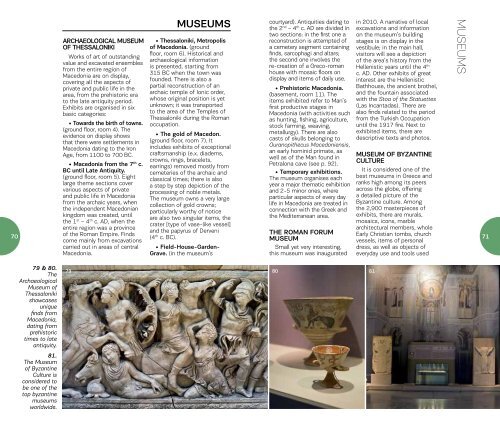Thessaloniki_EN
You also want an ePaper? Increase the reach of your titles
YUMPU automatically turns print PDFs into web optimized ePapers that Google loves.
70<br />
ARCHAEOLOGICAL MUSEUM<br />
OF THESSALONIKI<br />
Works of art of outstanding<br />
value and excavated ensembles<br />
from the entire region of<br />
Macedonia are on display,<br />
covering all the aspects of<br />
private and public life in the<br />
area, from the prehistoric era<br />
to the late antiquity period.<br />
Exhibits are organised in six<br />
basic categories:<br />
• Towards the birth of towns.<br />
(ground floor, room 4). The<br />
evidence on display shows<br />
that there were settlements in<br />
Macedonia dating to the Iron<br />
Age, from 1100 to 700 BC.<br />
• Macedonia from the 7 th c.<br />
BC until Late Antiquity.<br />
(ground floor, room 5). Eight<br />
large theme sections cover<br />
various aspects of private<br />
and public life in Macedonia<br />
from the archaic years, when<br />
the independent Macedonian<br />
kingdom was created, until<br />
the 1 st – 4 th c. AD, when the<br />
entire region was a province<br />
of the Roman Empire. Finds<br />
come mainly from excavations<br />
carried out in areas of central<br />
Macedonia.<br />
MUSEUMS<br />
• <strong>Thessaloniki</strong>, Metropolis<br />
of Macedonia. (ground<br />
floor, room 6). Historical and<br />
archaeological information<br />
is presented, starting from<br />
315 BC when the town was<br />
founded. There is also a<br />
partial reconstruction of an<br />
archaic temple of Ionic order,<br />
whose original position is yet<br />
unknown; it was transported<br />
to the area of the Temples of<br />
<strong>Thessaloniki</strong> during the Roman<br />
occupation.<br />
• The gold of Macedon.<br />
(ground floor, room 7). It<br />
includes exhibits of exceptional<br />
craftsmanship (e.x. diadems,<br />
crowns, rings, bracelets,<br />
earrings) removed mostly from<br />
cemeteries of the archaic and<br />
classical times; there is also<br />
a step by step depiction of the<br />
processing of noble metals.<br />
The museum owns a very large<br />
collection of gold crowns;<br />
particularly worthy of notice<br />
are also two singular items, the<br />
crater [type of vase-like vessel]<br />
and the papyrus of Derveni<br />
(4 th c. BC).<br />
• Field-House-Garden-<br />
Grave. (in the museum’s<br />
courtyard). Antiquities dating to<br />
the 2 nd – 4 th c. AD are divided in<br />
two sections: in the first one a<br />
reconstruction is attempted of<br />
a cemetery segment containing<br />
finds, sarcophagi and altars;<br />
the second one involves the<br />
re-creation of a Greco-roman<br />
house with mosaic floors on<br />
display and items of daily use.<br />
• Prehistoric Macedonia.<br />
(basement, room 11). The<br />
items exhibited refer to Man’s<br />
first productive stages in<br />
Macedonia (with activities such<br />
as hunting, fishing, agriculture,<br />
stock farming, weaving,<br />
metallurgy). There are also<br />
casts of skulls belonging to<br />
Ouranopithecus Macedoniensis,<br />
an early hominid primate, as<br />
well as of the Man found in<br />
Petralona cave (see p. 92).<br />
• Temporary exhibitions.<br />
The museum organises each<br />
year a major thematic exhibition<br />
and 2-5 minor ones, where<br />
particular aspects of every day<br />
life in Macedonia are treated in<br />
connection with the Greek and<br />
the Mediterranean area.<br />
THE ROMAN FORUM<br />
MUSEUM<br />
Small yet very interesting,<br />
this museum was inaugurated<br />
in 2010. A narrative of local<br />
excavations and information<br />
on the museum’s building<br />
stages is on display in the<br />
vestibule; in the main hall,<br />
visitors will see a depiction<br />
of the area’s history from the<br />
Hellenistic years until the 4 th<br />
c. AD. Other exhibits of great<br />
interest are the Hellenistic<br />
Bathhouse, the ancient brothel,<br />
and the fountain associated<br />
with the Stoa of the Statuettes<br />
(Las Incantadas). There are<br />
also finds related to the period<br />
from the Turkish Occupation<br />
until the 1917 fire. Next to<br />
exhibited items, there are<br />
descriptive texts and photos.<br />
MUSEUM OF BYZANTINE<br />
CULTURE<br />
It is considered one of the<br />
best museums in Greece and<br />
ranks high among its peers<br />
across the globe, offering<br />
a detailed picture of the<br />
Byzantine culture. Among<br />
the 2,900 masterpieces of<br />
exhibits, there are murals,<br />
mosaics, icons, marble<br />
architectural members, whole<br />
Early Christian tombs, church<br />
vessels, items of personal<br />
dress, as well as objects of<br />
everyday use and tools used<br />
MUSEUMS<br />
71<br />
79 & 80.<br />
The<br />
Archaeological<br />
Museum of<br />
<strong>Thessaloniki</strong><br />
showcases<br />
unique<br />
finds from<br />
Macedonia,<br />
dating from<br />
prehistoric<br />
times to late<br />
antiquity.<br />
79 80 81<br />
81.<br />
The Museum<br />
of Byzantine<br />
Culture is<br />
considered to<br />
be one of the<br />
top byzantine<br />
museums<br />
worldwide.


